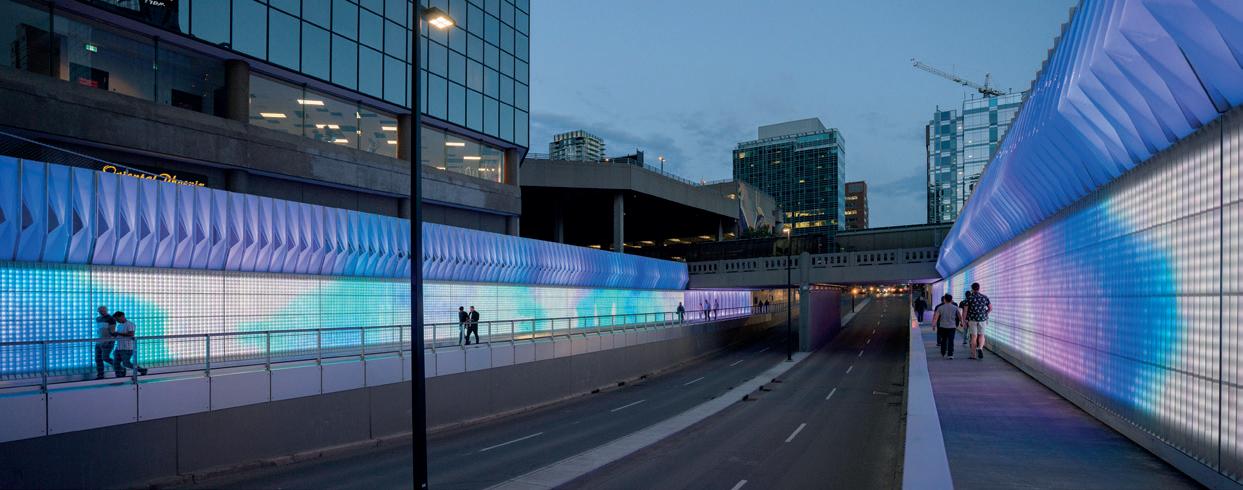
5 minute read
TIMBER
from FC&A May 2021
TAKING SUSTAINABILITY SERIOUSLY
Will Frost, National Product Manager for Engineered and Laminated Products at International Timber, explores the reasons why environmentally-friendly timber is becoming one of the most popular building materials, and gives advice to architects on ways to enhance sustainable timber specification and compliance.
Advertisement
INTERNATIONAL TIMBER
In Japan, there’s a five-storey timber Buddhist temple that’s stood for more than 1400 years. It’s the pinnacle of sustainable construction and illustrates what an extraordinary building material timber is.
The benefits of timber are vast. It’s more affordable, easier to work with and is inherently more lightweight than its modern counterparts. It’s also simpler to transport and handle, which makes it ideal for offsite manufacturing (OSM), providing even further cost and time savings. In fact, this is part of the reason
International Timber is now part of Saint-Gobain Off-Site Solutions, as timber is the ideal material for modern methods of construction (MMC).
When correctly procured, timber buildings have a reduced carbon footprint, while the raw materials act as carbon sinks and lock in greenhouse gases. For example, a single fivestorey building built from cross-laminated timber products can store approximately 400lbs of carbon for every 3ft2. Concrete, meanwhile, is responsible for 4 to 8% of the world’s carbon dioxide emissions, and if it was a country, it would rank third after China and the US.
For the industry, reaching net-zero carbon means delivering buildings that are carbon neutral in their operation, using materials produced via carbon-neutral processes, and employing carbon-neutral building methods. Making this switch can go a long way towards helping the construction industry reach the legally binding 2050 climate targets.
Timber trends
Without wishing to generalise, I’ve found that many architects nowadays do have a predisposition for timber buildings. A sector-wide objective to create incredible timber structures has been the driving force behind the recent leaps and bounds in timber designs.
Their ambitions challenge companies, like International Timber, to keep pushing the boundaries of what’s possible. To make these designs viable, we’ve spent five decades engineering out the flaws associated with raw timber, such as its tendency to expand and contract and torsional strength. This has led to huge advances in engineered timber solutions over the last few decades, and methods such as cross-laminated timber or glulam mean core timber structural components can achieve more, spanning farther and carrying heavier loads.
Keeping compliant
To upscale timber construction on a level required to impact on climate change targets, the built environment needs to understand the properties of timber and have full confidence when specifying it. However, we understand and acknowledge there’s a requirement for more support from consultants who are experienced in dealing with timber for applications in buildings.
It’s also incredibly important to note that each application of timber has its own set of guidance and regulations. International Timber, and other timber consultants, have vast experience and understanding of coatings and treatments which will assist specified timber in achieving those requirements.
The circular economy
Everyone involved in the production of a timber building is accountable for ensuring that timber is responsibly sourced. After all, timber is undoubtedly an outstanding, low-carbon choice for construction but only if it’s been procured in a sustainable and ethical way.
Only purchase timber from sustainable sources and aim for full Chain of Custody




(CoC)-certified timber. All suppliers are required to submit evidence on sustainability and corporate and social responsibility, which is taken into account when decisions are being made on whether to trade with them. To reduce your environmental impact, you should only use credible companies that have responsible procurement policies and the evidence to show they are following them. By purchasing CoC, you can ensure you are buying a product from a legal and well-managed source.
Also, taking steps such as using only Forest Stewardship Council (FSC)certified timber – as a minimum – ensures that the forests that produce the timber are well cared for and continue to play their role in storing carbon. Furthermore, acquiring FSC project certification can help to achieve increasingly popular environmental credentials, such as BREEAM, LEED and WELL. Outsourcing these elements to external partners can help ensure these standards are being met. For example, International Timber has a dedicated department for BREEAM consultation to help developers exceed environmental standards required.
We also take the whole carbon footprint into account, from source to installation – and beyond by managing issues such as waste. We procure the most sustainable species for the job while also exploring factors such as whether it’s more sustainable to manufacture the product at source or whether it can be delivered in one load.
Timber in the future
The Hōryū-ji temple in Japan shows us the potential lifespan of timber buildings when we create them right and care for them well. We should be following this principle, as one of the very best ways we can store carbon is by increasing the number of timber buildings. Considering timber as the default building material will be one of the most positive changes we can make towards tackling climate change. The Hōryū-ji temple in Japan








